Turning Blank Walls Into Boho Statement Spaces: 7 Simple Steps
I transformed my bland apartment walls by starting with a substantial macramé piece that made me smile, then layering in rattan mirrors and pampas grass for natural warmth. I created an eclectic gallery wall with mismatched vintage frames, added floating shelves with trailing plants, and hung a Turkish kilim as textile art. Warm Edison bulbs and handmade ceramics from my travels became the finishing touches. Each layer built upon the last, turning empty space into a curated sanctuary that tells my story—and yours can too once you understand how these elements work together.
Design Highlights
- Start with a large textured anchor piece (24+ inches) in natural fibers like cotton, jute, or wool to establish design direction.
- Layer natural elements including rattan mirrors, pampas grass in floor vases, and eucalyptus branches to add depth and dimension.
- Install three staggered floating shelves at different heights, mixing trailing plants, vintage brass items, and books with one-third empty space.
- Create a gallery wall using mismatched vintage frames with 2-3 inch spacing, arranging pieces on the floor before hanging.
- Hang vintage rugs as art using curtain rods or Velcro strips, layer textiles for depth, and add warm Edison lighting.
Start With a Textured Anchor Piece Like a Macramé Wall Hanging or Woven Tapestry
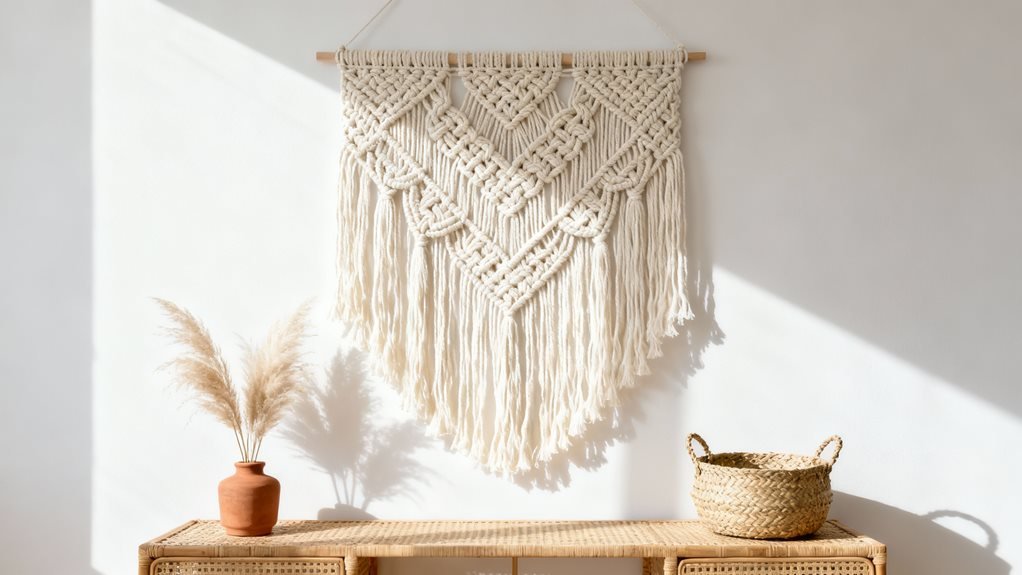
Why do the most alluring boho walls always seem to start with one stunning textured piece? I’ve learned it’s because texture creates instant visual interest and sets your entire design direction.
When I decorated my first apartment, I hung a large macramé piece above my couch, and suddenly everything else fell into place. That anchor piece told me exactly what colors, patterns, and additional elements would work.
Choose something substantial—at least 24 inches wide for impact. I prefer pieces with natural fibers like cotton, jute, or wool because they add warmth and authenticity.
Here’s my practical tip: hang your anchor piece first, then step back and live with it for a day or two. You’ll notice how the light hits it differently throughout the day, which helps you decide what to add next.
Don’t overthink this step. Your anchor piece should simply make you smile every time you see it.
Layer in Natural Elements With Rattan Mirrors and Dried Pampas Grass
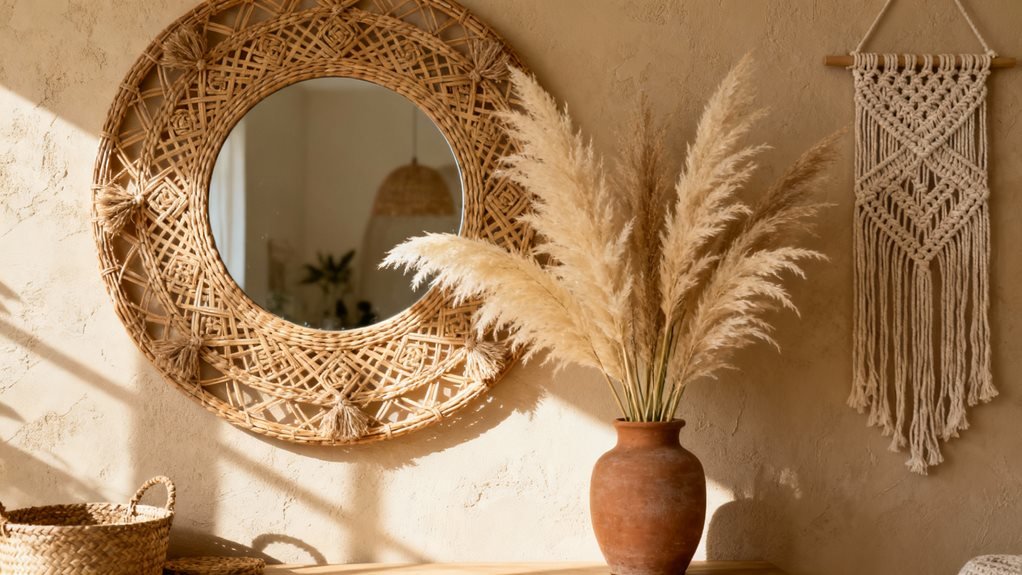
Once you’ve got your textured anchor piece up, natural elements become your secret weapon for building depth. I learned this after my living room wall looked flat despite having a gorgeous macramé hanging. Adding a rattan mirror changed everything.
Here’s how I arrange natural elements for maximum impact:
| Element | Placement | Effect | Vase Style |
|---|---|---|---|
| Pampas grass (3-5 stems) | Floor corner | Adds height | Large ceramic |
| Rattan mirror | Slightly off-center | Creates dimension | N/A |
| Eucalyptus branches | Side table | Brings movement | Tall glass |
| Palm leaves | Opposite corner | Balances composition | Woven basket |
Position your rattan mirror where it’ll catch natural light—this amplifies the boho warmth. I place mine about 6 inches away from my tapestry, creating intentional negative space.
For pampas grass, go with odd numbers. Three stems in a floor vase instantly adds that effortless, beachy vibe without overwhelming your wall arrangement.
Create a Gallery Wall Using Vintage Frames and Eclectic Artwork
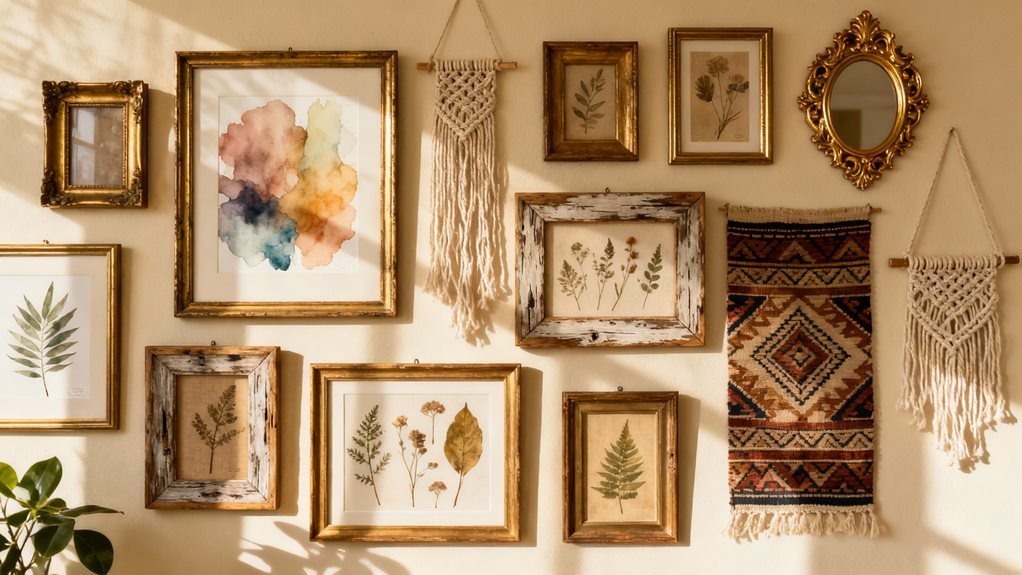
I’ve spent countless weekends hunting through flea markets and estate sales for vintage frames, and I’ve learned that the magic of a boho gallery wall lies in embracing the mismatch. The key is mixing ornate gold frames with simple wooden ones, pairing abstract prints alongside vintage botanical illustrations, and creating a layout that feels intentionally imperfect. Before you hammer a single nail, I recommend arranging everything on the floor first—this lets you play with spacing and composition until you find that sweet spot where eclectic feels cohesive rather than chaotic.
Sourcing Authentic Vintage Frames
The thrill of finding the perfect vintage frame at a dusty estate sale never gets old for me—there’s something magical about rescuing ornate gold frames with chipped corners or weathered wood pieces that tell their own stories. I’ve discovered my best sources through trial and error, and I’m sharing my go-to spots:
| Source Type | Why I Love It |
|---|---|
| Estate Sales | Authentic pieces with history, reasonable prices |
| Thrift Stores | Weekly inventory turnover, hidden gems |
| Antique Markets | Curated selection, negotiable pricing |
I always check frames for sturdy backing and glass quality. Don’t worry about perfect condition—imperfections add character. My rule: if it catches my eye and feels substantial, I grab it. Mix different finishes and sizes for that authentic boho look.
Mixing Art Styles Effectively
Now that you’ve collected those beautiful frames, let’s talk about what actually goes inside them—and this is where most people freeze up.
I’ll be honest: I once spent three hours rearranging my gallery wall because I’d grouped all my abstracts together. It looked sterile, not boho.
Here’s what works: alternate between different art styles. Place a vintage botanical print next to modern line art, then add a woven piece or small mirror. The key is intentional chaos—each piece should feel different, but they’ll harmonize through your frame selection.
I follow the “rule of three”: never hang more than three similar styles consecutively. Mix mediums too—photography, paintings, textiles, and prints all deserve space.
Trust your gut. If something feels off, it probably is.
Layout Planning and Spacing
Before you hammer a single nail, lay everything on the floor. I learned this the hard way after patching twelve holes in my living room wall. Arrange your frames exactly as they’ll hang, then measure the spacing between each piece. I keep mine between 2-3 inches for that relaxed boho vibe.
| Frame Size | Ideal Spacing | Best Placement |
|---|---|---|
| Large (16×20″) | 3-4 inches | Center/anchor points |
| Medium (11×14″) | 2-3 inches | Secondary focus areas |
| Small (5×7″) | 2 inches | Fill gaps, corners |
| Oversized (20×24″+) | 4-5 inches | Statement pieces |
| Tiny (4×6″) | 1-2 inches | Cluster groupings |
Snap a photo of your floor layout before hanging. You’ll thank me later.
Add Dimension With Floating Shelves Styled With Plants and Treasures
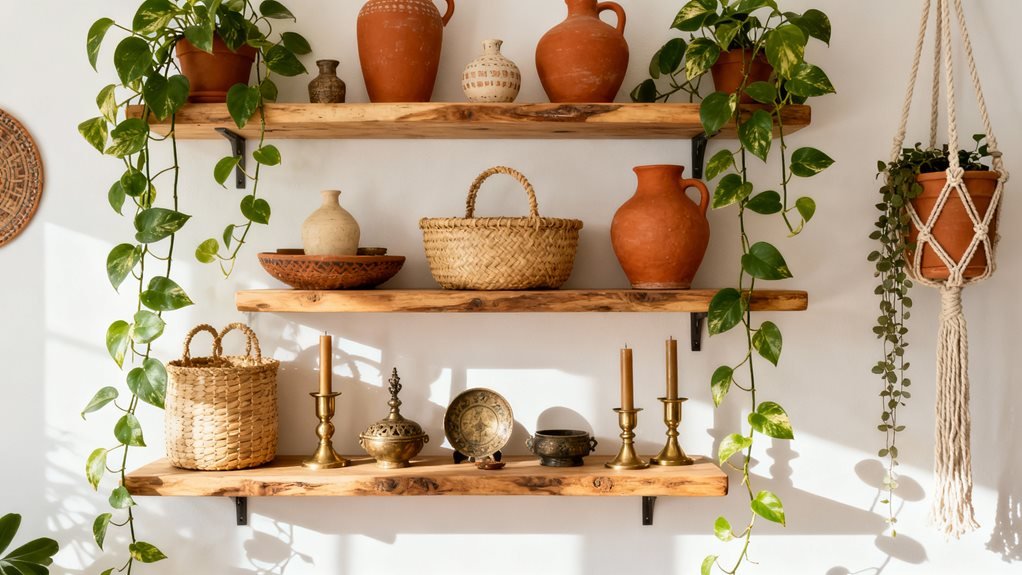
Floating shelves transformed my boring bedroom wall from flat and forgettable into a layered gallery that actually makes me smile every morning.
I installed three staggered shelves at different heights, creating visual interest instead of a rigid horizontal line. The key is mixing textures and heights—I paired trailing pothos with small succulents, vintage brass candlesticks, and a few favorite books stacked horizontally.
Don’t overcrowd your shelves. I leave about one-third of each shelf empty, letting items breathe. This prevents that cluttered thrift-store vibe and keeps things intentionally boho.
For plant placement, I position trailing varieties at shelf ends where they can cascade naturally. Smaller treasures like crystals, vintage finds, or handmade pottery fill middle sections.
Pro tip: Arrange items in odd numbers—groups of three or five look more organic than pairs. I rotate seasonal elements monthly, swapping dried flowers for fresh greenery or switching out decorative objects to keep my wall display feeling fresh and curated.
Incorporate Global-Inspired Textiles Like Kilim Rugs or Embroidered Fabrics
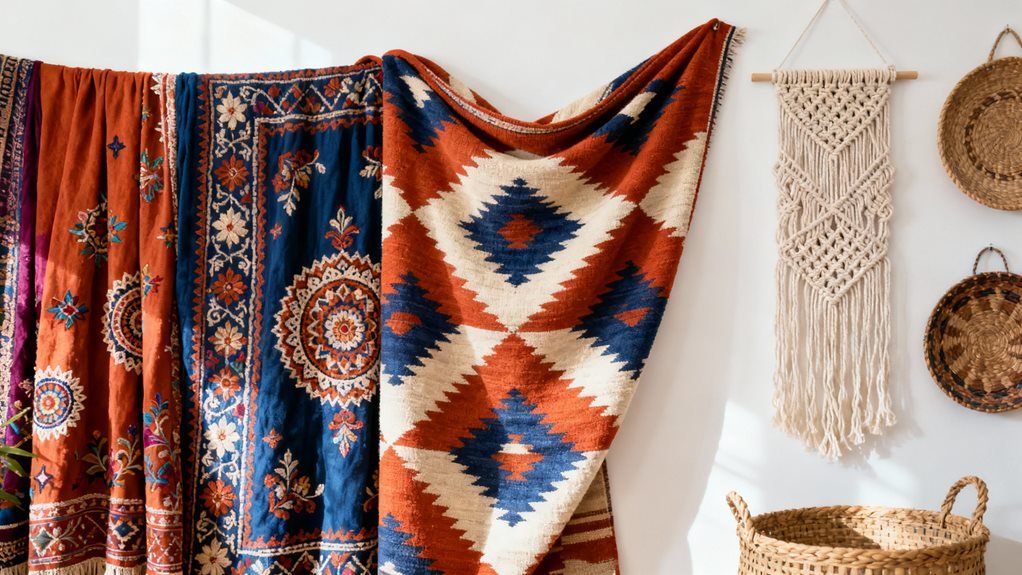
I fell in love with textiles during a trip to Morocco, where I watched weavers create intricate kilim patterns by hand—and I’ve been hanging rugs on my walls ever since. The key is choosing pieces with authentic patterns that tell a story, whether it’s a vintage Turkish kilim or hand-embroidered Suzani fabric from Central Asia. I layer these textiles at different heights and mix various textures to create depth, turning what could be simple wall hangings into a gallery of global craftsmanship.
Choosing Authentic Textile Patterns
When I first started collecting textiles for my walls, I made the rookie mistake of grabbing anything with geometric patterns, thinking it looked “boho enough.” What I’ve learned since then is that authentic global textiles carry stories in their weave—and that depth is what transforms a wall from decorated to genuinely riveting.
Here’s what I now look for:
- Turkish kilims with their flat-weave construction and symbolic motifs representing protection or fertility
- Moroccan wedding blankets featuring sequined diamond patterns against handwoven wool
- Indian kantha quilts showcasing running-stitch embroidery in vibrant, layered colors
- Mexican serapes displaying bold stripes in naturally dyed yarns
- Indonesian ikat with its distinctive blurred edges from resist-dyeing techniques
I source mine from fair-trade cooperatives and ethical vintage dealers who can verify origin stories.
Hanging Rugs as Art
I’ve hung vintage kilims in every home I’ve lived in, and they’ve become my favorite focal points. The key is choosing rugs with compelling patterns—Turkish kilims, Moroccan boucherouite, or Indian dhurries work beautifully.
For hanging, I use a simple curtain rod slipped through the rug’s weave or a Velcro strip attached to a wooden board. Never use nails directly through the fabric.
I’ve learned that smaller rugs (3×5 feet) work best above sofas or beds, while runners look stunning in narrow hallways. The texture adds warmth that flat art simply can’t match.
Layering Fabrics for Depth
Why stop at just one textile when you can create a rich, dimensional display? I’ve found that layering different fabrics transforms a flat wall into something truly alluring. My favorite approach? I’ll hang a large kilim rug as the base, then overlap it with a smaller embroidered Suzani throw or vintage tapestry.
Here’s what works beautifully together:
- A faded Turkish kilim beneath a vibrant Moroccan wedding blanket
- Neutral jute wall hanging layered with colorful Indian block-print fabric
- Vintage tapestry paired with a macramé piece for texture contrast
- Indonesian batik cloth underneath a smaller embroidered panel
- Guatemalan textiles mixed with Mexican woven blankets
The key is varying textures and scales while maintaining a cohesive color story. This creates depth that makes your wall feel intentionally curated rather than cluttered.
Mix in Warm Lighting With String Lights or Woven Pendant Lamps
Lighting transforms a bare wall from flat to [captivating] faster than any other design element I’ve tried. I discovered this when I hung Edison bulb string lights above my bedroom tapestry—suddenly, the whole space felt alive and intentional.
I recommend positioning string lights in a gentle swag pattern or draping them around wall hangings to create ambient glow. For a more polished look, I’ll mount a woven rattan pendant lamp slightly off-center from the wall arrangement. The natural texture casts beautiful shadows that change throughout the day.
Here’s what works: warm white bulbs (2700K-3000K) give that signature boho warmth without feeling too yellow. I avoid cool white bulbs—they kill the cozy vibe instantly.
Pro tip: Install a dimmer switch. I can adjust the mood from bright and energizing during the day to soft and relaxing at night. This flexibility makes the wall display feel dynamic rather than static.
Finish With Personal Touches Like Travel Souvenirs and Handmade Ceramics
The moment I placed my grandmother’s hand-thrown ceramic bowl on a floating shelf next to a woven basket from Morocco, my wall display finally felt like *mine*. That’s when I realized boho style isn’t about buying the trendiest pieces—it’s about curating items that tell your story.
I’ve learned to layer these personal treasures throughout my wall arrangements:
- Vintage postcards from flea markets tucked into macramé holders
- Small terra-cotta planters I made during a pottery class
- A brass compass from my hiking trip through Peru
- Hand-painted tiles collected from different neighborhoods
- My best friend’s handmade candles on decorative ledges
These finishing touches transform your space from “Pinterest board” to “this is where I actually live.” I always leave gaps between items so each piece can breathe and catch your eye. The imperfections in handmade ceramics and weathered souvenirs add character that mass-produced décor simply can’t replicate.
Frequently Asked Questions
How Do I Hang Heavy Wall Decor Without Damaging Rental Walls?
I’ve rescued my security deposit more times than I can count! For heavy boho pieces, I swear by adhesive hooks rated for the weight—they peel off cleanly. I also use picture-hanging strips for mirrors and woven art. My favorite trick? Lean oversized pieces against the wall on a console table instead of hanging them. Command strips have never failed me, but always check the weight limit first. Your landlord will thank you!
What’s the Ideal Spacing Between Items in a Boho Gallery Wall?
I like to eyeball 2-3 inches between pieces—think of it as giving each item room to breathe while keeping that cozy, collected vibe alive. When I created my bedroom gallery wall, I started tighter (around 2 inches) for smaller pieces and went wider for larger ones. Here’s my trick: lay everything on the floor first, snap a photo, then replicate it on your wall. It’s foolproof!
How Can I Achieve Boho Style on a Tight Budget?
I’ve created countless boho spaces on a shoestring! Hit up thrift stores for vintage frames and baskets—I once scored five woven pieces for under $20. Mix in DIY macramé (YouTube’s your friend here), and print your own botanical art. I’ll swap expensive tapestries for patterned fabric remnants or even scarves. Natural elements like driftwood and dried flowers are free if you’re willing to forage. The boho vibe thrives on eclectic mixing anyway!
What Color Palette Works Best for Bohemian Wall Spaces?
I’ll paint you a picture: warm terracottas, burnt oranges, and dusty pinks are my go-to bohemian base colors. I’ve learned that mixing these earthy tones with deep teals, mustard yellows, and rich burgundies creates that signature boho vibe. Here’s my trick—I always include cream or off-white to balance the boldness. Last year, I transformed my living room by layering these colors through tapestries and artwork, and it’s still my favorite space.
How Do I Prevent My Boho Wall From Looking Cluttered?
I keep my boho walls balanced by following the “rule of three”—grouping items in odd numbers creates visual harmony without chaos. I’ll anchor my space with one large statement piece, then layer smaller elements around it. White space is crucial; I leave breathing room between hangings so each piece shines. When I step back and my eye travels smoothly across the wall rather than darting frantically, I know I’ve nailed it.
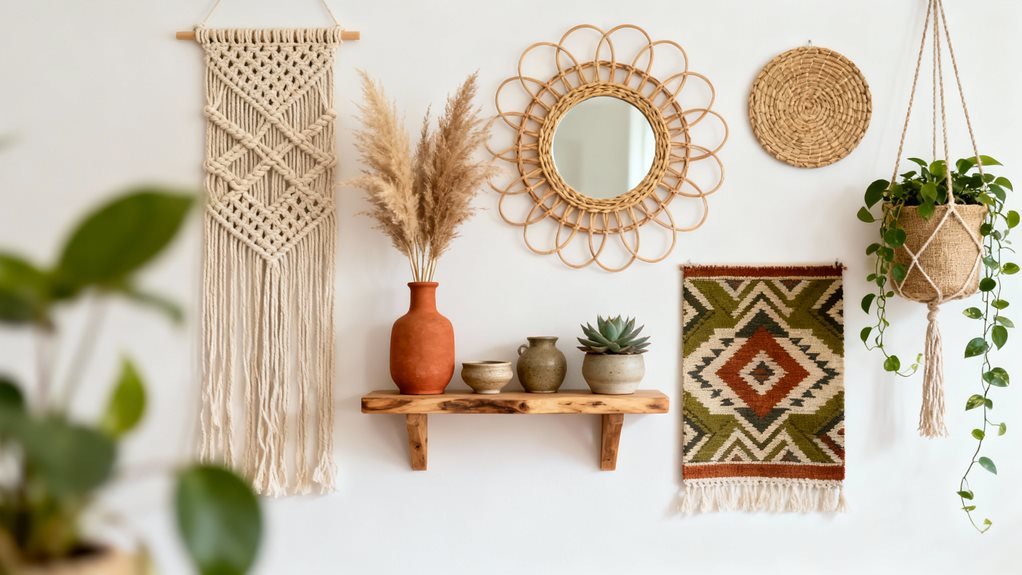
Leave a Reply